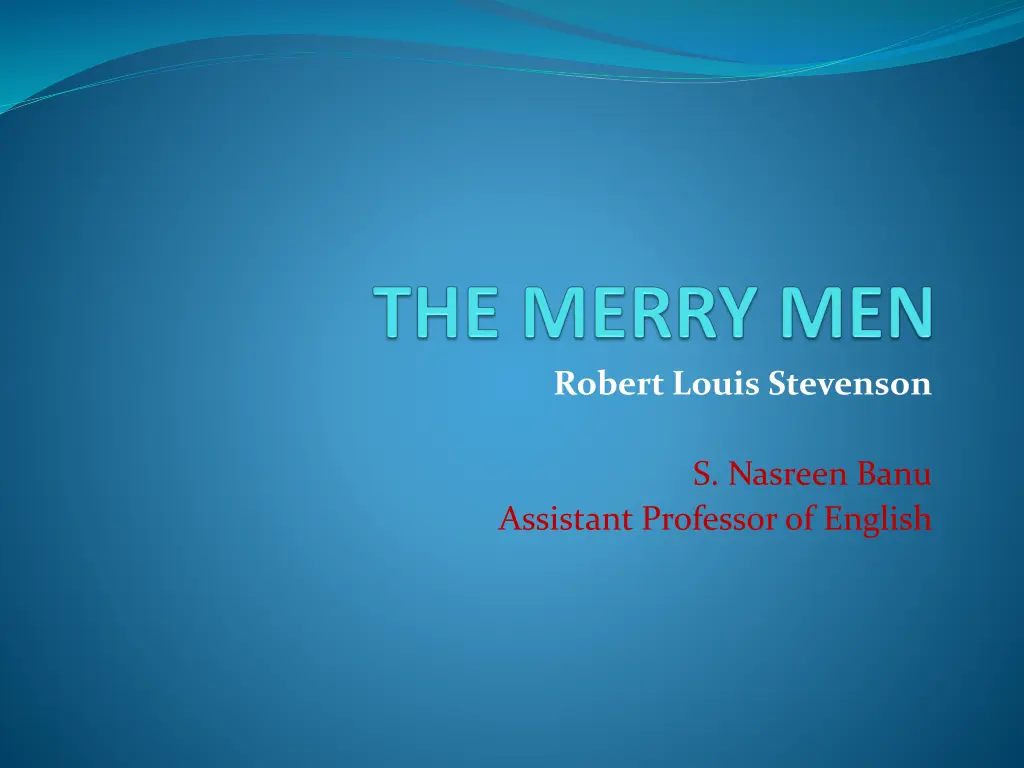
Life and Works of Robert Louis Stevenson: A Scottish Novelist
Discover the fascinating life of Robert Louis Stevenson, a renowned 19th-century Scottish writer known for classics like "Treasure Island" and "Strange Case of Dr. Jekyll and Mr. Hyde". Explore his early life, literary success, and final years spent in the Pacific Islands.
Download Presentation

Please find below an Image/Link to download the presentation.
The content on the website is provided AS IS for your information and personal use only. It may not be sold, licensed, or shared on other websites without obtaining consent from the author. If you encounter any issues during the download, it is possible that the publisher has removed the file from their server.
You are allowed to download the files provided on this website for personal or commercial use, subject to the condition that they are used lawfully. All files are the property of their respective owners.
The content on the website is provided AS IS for your information and personal use only. It may not be sold, licensed, or shared on other websites without obtaining consent from the author.
E N D
Presentation Transcript
Robert Louis Stevenson S. Nasreen Banu Assistant Professor of English
Who Is Robert Louis Stevenson? Robert Louis Stevenson was a 19th-century Scottish writer notable for such novels as 'Treasure Island,' 'Kidnapped' and 'Strange Case of Dr. Jekyll and Mr. Hyde. 1850 1894
Robert Louis Stevenson Novelist Robert Louis Stevenson traveled often, and his global wanderings lent themselves well to his brand of fiction. Stevenson developed a desire to write early in life, having no interest in the family business of lighthouse engineering. He was often abroad, usually for health reasons, and his journeys led to some of his early literary works. Publishing his first volume at the age of 28, Stevenson became a literary celebrity during his life when works such as Treasure Island, Kidnapped and Strange Case of Dr. Jekyll and Mr. Hyde were released to eager audiences.
Early Life Robert Louis Balfour Stevenson was born in Edinburgh, Scotland, on November 13, 1850, to Thomas and Margaret Stevenson. Lighthouse design was his father's and his family's profession, and so at the age 17, Stevenson enrolled at Edinburgh University to study engineering, with the goal of following his father in the family business. Lighthouse design never appealed to Stevenson, though, and he began studying law instead. His spirit of adventure truly began to appear at this stage, and during his summer vacations, he traveled to France to be around young artists, both writers and painters. He emerged from law school in 1875 but did not practice, as, by this point, he felt that his calling was to be a writer.
Final Years In June 1888, Stevenson and his family set sail from San Francisco, California, to travel the islands of the Pacific Ocean, stopping for stays at the Hawaiian Islands, where he became good friends with King Kal kaua. In 1889, they arrived in the Samoan islands, where they decided to build a house and settle. The island setting stimulated Stevenson's imagination, and, subsequently, influenced his writing during this time: Several of his later works are about the Pacific isles, including The Wrecker (1892), Island Nights' Entertainments (1893), The Ebb-Tide (1894) and In the South Seas (1896).
Final Years Toward the end of his life, Stevenson's South Seas writing included more of the everyday world, and both his nonfiction and fiction became more powerful than his earlier works. These more mature works not only brought Stevenson lasting fame, but they also helped to enhance his status with the literary establishment when his work was re-evaluated in the late 20th century, and his abilities were embraced by critics as much as his storytelling had always been by readers. Stevenson died of a stroke on December 3, 1894, at his home in Vailima, Samoa. He was buried at the top of Mount Vaea, overlooking the sea.
Plot summary The narrator, Charles Darnaway, a recent graduate of the University of Edinburgh travels to the remote island of Aros off the north-west coast of Scotland. Aros is the home of his uncle, Gordon Darnaway, a hard-hearted and alcoholic Presbyterian. Charles has come in search of sunken treasure, as he believes a ship of the Spanish Armada sank in the bay under his uncle's home long before. Charles hopes to use the treasure to restore the Darnaways' fortunes and marry Gordon's daughter (and Charles' cousin) Mary Ellen.
Plot summary (cont.) Charles is rowed out to the promontory by the only other inhabitant, Gordon's servant Rorie. Charles is surprised to find both Rorie and Gordon anxious and full of foreboding, though both furtively evade his questions, he is further surprised to find his uncle's austere home decorated with expensive lamps and rugs. He realizes at once they must have come from a shipwreck, and feels uneasy about this looting of the dead, his cousin Mary Ellen confirms that a ship was recently cast away nearby, having been driven by a storm into the dreadful breakers around the promontory, breakers that roar a hundred feet high around the rocks and are called "the Merry Men" due to the vast noise they make, like shrieking laughter.
Plot summary (cont.) Charles goes down to the shore on his treasure-hunt. While there he sees the shattered hull of the wrecked ship, and also a fresh grave, he realizes the grave must be for the body of a marinerwashed ashore. He takes this as a bad omen,
Plot summary (cont.) but still sets out to the point where he thinks the Spanish ship must be, his first dive locates a weed-grown structure which appears to be the sunken ship, but a second dive shows it to be only a rock formation. He hauls himself along the weed-grown rocks, looking for signs of the wreck, until the signs of an approaching storm warn him to return to shore; as he makes for the surface his handhold breaks off in his grip; when he pulls himself on shore he looks at it and is horrified to recognize a human leg bone. He lays the bone on the sand, resolving to do no more hunting for the wreck.
Plot summary (cont.) On his way back to the house he sees a small boat, full of strangers, rowing around the bay. Watching them he is convinced that they too are searching for the sunken Spanish ship, he returns to tell his uncle that he saw a stranger on the shore, and is surprised by Gordon's panicked dread. Charles realizes that the mariner whose grave he saw came ashore alive, and that his uncle murdered him. Gordon runs out into the storm, with Charles after him, only to see the strangers' ship caught in the Merry Men and destroyed.
Plot summary (cont.) Further down the shore they find a man standing in the hull of the earlier wreck, a black man who speaks no language Charles knows. By sign language the stranger signifies that he is one of the strangers' party that was left behind, but Gordon, his guilty conscience overwhelming him, believes him to be the ghost of the man he murdered. Driven mad, Gordon flees into the storm and eventually flings himself into the sea, pursued by the silent stranger; both are swallowed up by the Merry Men.






















